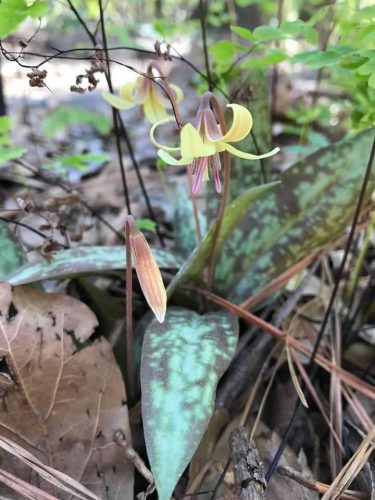
The tiny Trout Lilly is one of Georgia’s many unique native plant species.
As temperatures begin to warm and spring approaches, the first of the woodland plants begin to peek above the leaf litter. One of the first to emerge is the spring-ephemeral (short-lived) Trout Lily (Erythronium americanum). Trout Lily’s leaves and flowers spring from the ground, bloom, and die before the trees of the forest leaf out.
The small Trout Lily starts its life cycle with one to two mottled leaves that sprout from the leaf litter. As it flowers, the plant produces a single 5 to 8-inch bronze-colored stalk with a nodding bloom on end. The flower is typically yellow on the inside and bronze on the outside. The petals sharply curve backward to reveal six bronze stamens. One interesting thing to note about the Trout Lily is that blooms are only found on plants that have two leaves.
Did you know that the Trout Lily has an interesting way of dispersing its seeds? Typically when a person thinks of seed dispersal, they may envision a seed set adrift by the wind or hitching a ride on the fur of an animal. This unusual plant relies on the lowly ant as an agent of seed dispersal. The Lily’s seed has a coating that ants find irresistible. The ants will carry off the seeds, take them underground, devour the seed coating, and leave the rest of the seed to sprout!
The Trout Lily has several names: Trout Lily, Adder’s Tongue, and Dog’s Tooth Violet. Trout Lily is the more common of the three titles. Why the name Trout Lily? The mottled color of the leaves is similar to that of the skin of a trout. The name Adder’s Tongue came about from the stamens sticking out of the curved petals mimicking the tongue of an adder. It is believed that the name Dog’s Tooth Violet comes from the root. There is a tiny bulb at the base of the root that resembles a small, white dog’s tooth.
Although there are no medicinal uses today, the Trout Lily was used by Native Americans as a source of medicine. The Cherokee would warm the leaves and crush them to extract the juice. They would then pour the leaf juice over a wound that was being stubborn to heal. They would also make an infusion from the root and use it to treat fevers. Iroquois women would chew raw leaves to prevent conception while Cherokee men would spit the juice of the plant root into the river, hoping to make the fish bite.
If you would like to learn more about the beautiful Trout Lily, you can visit the Native American Ethnobotany Database, Lady Bird Johnson Wildflower Center, and the USDA Plants Database.

